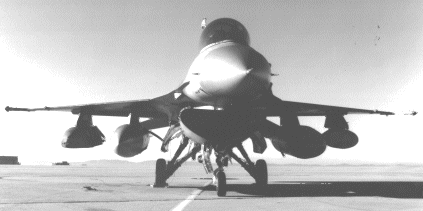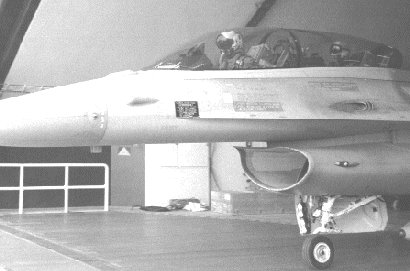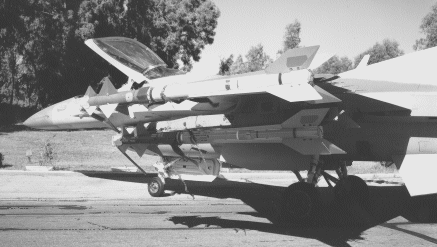
Graham Warwick/FORT WORTH
Although it has the current best-seller on the fighter market, Lockheed Martin is aware that the market is changing. Competition and economic pressures are driving efforts to reduce cost and increase capability of the F-16.
The most pressing issue facing Lockheed Martin is avoiding the production gap that will occur, based on current orders, in 2001. The company will build 105 F-16s this year, but production will the decline to 57 in 1999, 34 in 2000 and only 11 in 2001 when, on current orders, the last aircraft will be delivered.
Production is then scheduled to restart in 2002 to fulfil the 80-aircraft order now being negotiated with the United Arab Emirates (UAE). Under the current plan, production would ramp up to 36 a year before shutting down again in 2004. This would leave a three-year gap until production of the Joint Strike Fighter (JSF) gets underway - assuming Lockheed Martin wins the competition, and assuming the JSF programme stays on schedule.
The priorities, according to market development director Robert Keighery, are: to fill the 2001 gap; to then increase production above that planned for the UAE; to fill the 2004-2007 gap; and to keep the F-16 in production beyond the start of JSF deliveries, both as a back-up and as an alternative to the new fighter.
DRIVING DOWN LEAD TIME
The first of those is probably the toughest. The last aircraft, on current orders, is scheduled to be delivered to the US Air Force in April 2001. With the traditional 36-month lead time, an F-16 ordered today would not be delivered until July 2001. But Lockheed Martin has driven down lead times and can now produce the current Block 50-standard aircraft in 24 months.
Contract negotiation and aircraft configuration would add to the lead time, but the potential exists for aircraft to be delivered beginning in October 2000 if an existing customer placed a repeat order. Several F-16 operators are looking at top-up purchases, Keighery says.
Lockheed Martin sees the "realistic" potential to sell a further 500 aircraft over the next 10 years, says F-16 programmes director Kevin Dwyer. Between 1,500 and 2,000 fighters will "come of age" over that period, but they will not be replaced one-for-one, he says. This leaves a real market for around 1,000 aircraft, of which Lockheed Martin expects to capture "a little more than half" with the F-16.
Of those 500 sales, a half or more will be to existing F-16 operators, Dwyer says. Lockheed Martin is in "ongoing negotiations" with more than half of the almost 20 existing F-16 operators on follow-on purchases, he says.
Securing substantial new sales is not going to be easy, however, not least because most of the fighter procurements under way have been, or could be, affected by economic issues. Chile's competition for 12-24 aircraft, which was to have been decided in June, has been postponed indefinitely because of the knock-on effects of the Asian economic crisis. The Philippines has similarly delayed a planned purchase of 12-24 fighters because of economic problems.
Other campaigns under way include:
Greece - 40-60 aircraft. Bidders will respond to a request for information in August-September, with a decision expected by early next year; Israel - 40-60 aircraft. A letter of request is expected in October, leading to a selection in the first quarter of next year; Norway - 40 aircraft. A decision is not expected until the first quarter of 2000, but Norway wants quick delivery.Although these procurements look secure, there is no guarantee that they will proceed on schedule, or that Lockheed Martin can win all three. In Greece, an existing F-16 operator, the aircraft is up against the Boeing F-15E, Dassault Mirage 2000-5, Eurofighter EF2000 and a Sukhoi Su-27 derivative. Greece also faces budget pressures, as it tries to meet the criteria for entry into European Monetary Union.
In Israel, another F-16 operator, the aircraft is again up against the F-15E - a contest it lost last time around. This time the requirement is different, Lockheed Martin says, and the issue of aircraft numbers is a bigger factor. Israel has given "no clear indication" on the possibility of a split purchase, the company says.
In Norway, the F-16 is up against the EF2000. Here the issue is the country's requirement for highly detailed cost and performance data ahead of a decision, so that the programme can proceed quickly to contract award. The information requested goes beyond the price and availability data normally supplied by the US Government. "We'll be working that through next year," the company says.

USED AIRCRAFT AVAILABILITY
Beyond these new-aircraft prospects, the sale or lease of used F-16A/Bs continues to be a possibility. The Government has offered surplus US Air Force aircraft, as well as the embargoed Pakistani F-16s, as interim fighters in East Europe, the Far East and Latin America. So far, the availability of these aircraft has not affected significantly - positively or negatively - sales prospects for new F-16s.
Used aircraft may become more of a factor in the sale of Mid-Life Update (MLU) kits for the F-16A/B. Portugal is close to acquiring enough surplus-USAF aircraft to equip a second squadron, then upgrading all of its F-16s to MLU standard. The Pakistani aircraft, meanwhile, have caught the attention of Poland which, like the Czech Republic and Hungary, wants to acquire NATO-standard aircraft but faces economic difficulties.
Although the US Government is responsible for their marketing, the ready availability of used F-16s is seen by Lockheed Martin as an advantage in some fighter competitions. Where only new aircraft are under consideration, the company believes that the aircraft's cost and capability are its biggest selling points.
Five years ago, Lockheed Martin announced that it had reduced the price of a USAF-standard Block 50 F-16C to $20 million, despite a dramatic reduction in production rate. Today, says Dwyer, the same aircraft actually costs slightly less - around $19.5 million in 1994 dollars. This is because of manufacturing improvements at Lockheed Martin and cost reductions negotiated with suppliers, he says.
Despite the reduction in rate, the Fort Worth plant still builds a surprising number of different F-16 variants. The F-16A/B is still in production for Taiwan in Block 20 form, which incorporates the MLU improvements on the assembly line. The Block 40 night-attack F-16C/D is still in production for Bahrain and Egypt, while the latest Block 50 F-16C/D will incorporate several improvements beginning with 1999 deliveries to the USAF. The UAE deal will add a new model to the line, the so-called "Block 60" F-16.
Dwyer does not anticipate any sales of the F-16A/B beyond the Taiwan order, as the Block 20 aircraft is only marginally cheaper than the Block 50 F-16C/D. The Block 40 aircraft will continue to be available for re-order by customers already operating the type, as is the case with Bahrain and Egypt, but new sales are expected to focus on the current Block 50, enhanced Block 50+ and "advanced capability" Block 60 aircraft.
The Block 50 F-16C/D will be improved beginning in 1999 when the USAF takes delivery of aircraft equipped with the modular mission computer and colour cockpit displays developed for the F-16A/BMLU. Greece, Israel and Norway, meanwhile, are being offered what Lockheed Martin describes as the "Block 50+".
According to Robert Elrod, vice-president for F-16, the Block 50+ is not a specific configuration, but rather a menu of capabilities which can be added to the current Block 50. These enhancements come from the MLU; from the Common Configuration Implementation Programme (CCIP) launched by the USAF to upgrade its Block 40s and 50s with common avionics; and from the Block 60.

POTENTIAL FOR ENHANCEMENT
The potential enhancements are numerous. The MLU introduces capabilities such as the Improved Data Modem, which allows datalink communications, and the Digital Terrain System, which improves navigation and safety. The CCIP will add the Link 16 datalink, AIM-9X high off-boresight air-to-air missile and associated Joint Helmet-Mounted Cuing System, the Common Missile Warning System and stand-off weapons. Improvements to the basic APG-68 radar are also being offered as part of the Block 50+.
Beyond that, enhancements developed for the Block 60 aircraft can be incorporated into the Block 50+, although Lockheed Martin is coy about what exactly is being offered. Arguing that the "Block 60" designation is not official, and applies to a specific customer's configuration, Elrod prefers to talk generically about an "advanced capability" F-16.
What those advanced capabilities are, however, is fairly clear. They include: an active-array radar; internally mounted forward-looking infrared (FLIR)/targeting system; advanced cockpit with larger colour displays; new digital flight controls; more powerful engine; and conformal fuel tanks to extend range.
The fuselage-mounted conformal tanks, coupled with larger, 2,275 litre (600USgal) underwing tanks already cleared on the F-16, extend the strike range substantially. Ahose-and-drogue aerial refuelling capability, probably based on a probe housed in a modified fuel tank, is also being looked at in response to customer interest.
Customers are also showing keen interest in a two-seater with "missionised" back seat, which requires installation of the spine developed originally for Israeli F-16Ds. This capability, combined with the conformal tanks, is driving the need to update the flight control computer, Elrod says.
Enhanced increased-performance engines are now available from both General Electric (F110-129EFE) and Pratt & Whitney (F100-229A), increasing the thrust class to 142kN, from the current 129kN. Engine life and fuel consumption are also improved.
Advanced weaponry is becoming available, with USAF plans to clear the AIM-9X, Joint Direct Attack Munition, Joint Stand-Off Weapon and Joint Air-to-Surface Stand-Off Missile on the F-16C/D. European MLU nations are looking at several alternative short-range air-to-air missiles.
Existing operators of F-16s armed with the High-speed Anti-Radiation Missile are pushing the USA to release the ASQ-213 HARM targeting system. Lockheed Martin, meanwhile, is offering the alternative Litton LR-100 emitter targeting system.
Lockheed Martin sees the F-16 as a "natural bridge" until the JSF is available for export. Elrod expects the F-16 to remain in production to around 2010, and in service to beyond 2030. "Realistically, for some customers, this aircraft may stay in service to 2050," he believes.
Source: Flight International























